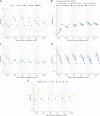Higher risk of death from COVID-19 in low-income and non-White populations of São Paulo, Brazil
- PMID: 33926892
- PMCID: PMC8094342
- DOI: 10.1136/bmjgh-2021-004959
Higher risk of death from COVID-19 in low-income and non-White populations of São Paulo, Brazil
Abstract
Introduction: Little evidence exists on the differential health effects of COVID-19 on disadvantaged population groups. Here we characterise the differential risk of hospitalisation and death in São Paulo state, Brazil, and show how vulnerability to COVID-19 is shaped by socioeconomic inequalities.
Methods: We conducted a cross-sectional study using hospitalised severe acute respiratory infections notified from March to August 2020 in the Sistema de Monitoramento Inteligente de São Paulo database. We examined the risk of hospitalisation and death by race and socioeconomic status using multiple data sets for individual-level and spatiotemporal analyses. We explained these inequalities according to differences in daily mobility from mobile phone data, teleworking behaviour and comorbidities.
Results: Throughout the study period, patients living in the 40% poorest areas were more likely to die when compared with patients living in the 5% wealthiest areas (OR: 1.60, 95% CI 1.48 to 1.74) and were more likely to be hospitalised between April and July 2020 (OR: 1.08, 95% CI 1.04 to 1.12). Black and Pardo individuals were more likely to be hospitalised when compared with White individuals (OR: 1.41, 95% CI 1.37 to 1.46; OR: 1.26, 95% CI 1.23 to 1.28, respectively), and were more likely to die (OR: 1.13, 95% CI 1.07 to 1.19; 1.07, 95% CI 1.04 to 1.10, respectively) between April and July 2020. Once hospitalised, patients treated in public hospitals were more likely to die than patients in private hospitals (OR: 1.40%, 95% CI 1.34% to 1.46%). Black individuals and those with low education attainment were more likely to have one or more comorbidities, respectively (OR: 1.29, 95% CI 1.19 to 1.39; 1.36, 95% CI 1.27 to 1.45).
Conclusions: Low-income and Black and Pardo communities are more likely to die with COVID-19. This is associated with differential access to quality healthcare, ability to self-isolate and the higher prevalence of comorbidities.
Keywords: cross-sectional survey; epidemiology; geographic information systems; mathematical modelling; public health.
© Author(s) (or their employer(s)) 2021. Re-use permitted under CC BY. Published by BMJ.
Conflict of interest statement
Competing interests: None declared.
Figures





Similar articles
-
Ethnic and regional variations in hospital mortality from COVID-19 in Brazil: a cross-sectional observational study.Lancet Glob Health. 2020 Aug;8(8):e1018-e1026. doi: 10.1016/S2214-109X(20)30285-0. Epub 2020 Jul 2. Lancet Glob Health. 2020. PMID: 32622400 Free PMC article.
-
Sociodemographic factors associated with COVID-19 in-hospital mortality in Brazil.Public Health. 2021 Mar;192:15-20. doi: 10.1016/j.puhe.2021.01.005. Epub 2021 Jan 15. Public Health. 2021. PMID: 33607516 Free PMC article.
-
Associations of Individual and Neighborhood Factors with Disparities in COVID-19 Incidence and Outcomes.West J Emerg Med. 2025 Mar;26(2):315-325. doi: 10.5811/westjem.18526. West J Emerg Med. 2025. PMID: 40145927 Free PMC article.
-
Racial and Ethnic Disparities in COVID-19-Related Infections, Hospitalizations, and Deaths : A Systematic Review.Ann Intern Med. 2021 Mar;174(3):362-373. doi: 10.7326/M20-6306. Epub 2020 Dec 1. Ann Intern Med. 2021. PMID: 33253040 Free PMC article.
-
Antibody tests for identification of current and past infection with SARS-CoV-2.Cochrane Database Syst Rev. 2020 Jun 25;6(6):CD013652. doi: 10.1002/14651858.CD013652. Cochrane Database Syst Rev. 2020. Update in: Cochrane Database Syst Rev. 2022 Nov 17;11:CD013652. doi: 10.1002/14651858.CD013652.pub2. PMID: 32584464 Free PMC article. Updated.
Cited by
-
Effects of non-pharmaceutical interventions on social distancing during the COVID-19 pandemic: Evidence from the 27 Brazilian states.PLoS One. 2022 Mar 17;17(3):e0265346. doi: 10.1371/journal.pone.0265346. eCollection 2022. PLoS One. 2022. PMID: 35298529 Free PMC article.
-
COVID-19 mortality: educational inequalities and socio-spatial context in two provinces of Argentina.Rev Peru Med Exp Salud Publica. 2024 Aug 19;41(2):171-177. doi: 10.17843/rpmesp.2024.412.13201. Rev Peru Med Exp Salud Publica. 2024. PMID: 39166640 Free PMC article.
-
Long-term commuting times and air quality relationship to COVID-19 in São Paulo.J Transp Geogr. 2022 May;101:103349. doi: 10.1016/j.jtrangeo.2022.103349. Epub 2022 Apr 15. J Transp Geogr. 2022. PMID: 35440861 Free PMC article.
-
Covid-19 hospital mortality using spatial hierarchical models: cohort design with 74,994 registers.Rev Saude Publica. 2023 May 26;57(suppl 1):2s. doi: 10.11606/s1518-8787.2023057004652. eCollection 2023. Rev Saude Publica. 2023. PMID: 37255113 Free PMC article.
-
The impact of the socioeconomic factor on Parkinson's disease medication adherence: a scoping review.Arq Neuropsiquiatr. 2024 Feb;82(2):1-8. doi: 10.1055/s-0044-1779608. Epub 2024 Feb 23. Arq Neuropsiquiatr. 2024. PMID: 38395420 Free PMC article.
References
-
- Marmot M, Wilkinson R. Social determinants of health. OUP Oxford, 2005.
MeSH terms
Grants and funding
LinkOut - more resources
Full Text Sources
Other Literature Sources
Medical
Miscellaneous
